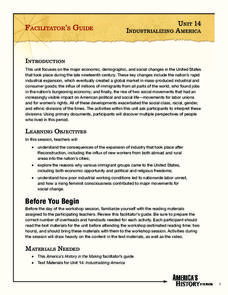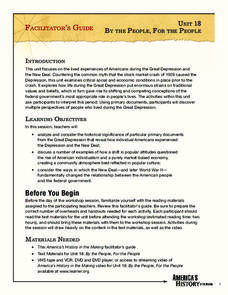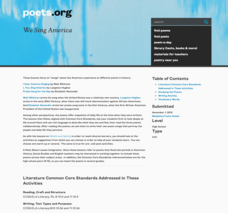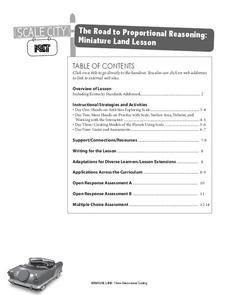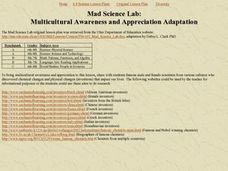Annenberg Foundation
Controversial Issues in Practice
Wow! This resource provides three related lessons on the First Amendment that challenge US government students to explore their personal opinion on the separation of church and state. Each lesson can be adjusted in length, but is...
Annenberg Foundation
Industrializing America
Imagine an eight year old spindle boy working barefoot in a factory in the late 1800s. Scholars research the industrial period in American history in the 14th lesson of a 22-part series that explores the country's background. Groups...
Annenberg Foundation
By the People, For the People
A picture speaks a thousand words—no matter how old. The 18th installment of a 22-part series on the making of American history has scholars research the causes of the Great Depression and the factors of the New Deal. Using photographic...
Annenberg Foundation
Global America
It's not really a small world after all! The 21st lesson of a 22-part series on American history researches the impact of globalization on the United States. Using photographic and written references materials, as well as video sources,...
Curated OER
But I'm Not a Writing Teacher!
How teaching writing skills in the science classroom will benefit your students as they transition to Common Core.
Curated OER
Cultural Connections
Students explore the concept of philanthropy. In this service learning instructional activity, students examine the impact of the works of Cesar Chavez, George Washington Carver, Sunderlal Buhuguna, and Abdul Sattar Edhi.
Academy of American Poets
We Sing America
Pair the famous poems "I Hear America Singing," by Walt Whitman, and "I, Too, Sing America," by Langston Hughes, with a more recent poem by Elizabeth Alexander called "Praise Song for the Day" to demonstrate a theme and introduce your...
Curated OER
Moving and Grooving with Tempo:
Students are able to repeat various movements. They are able to state the definition of tempo. Students are able to distinguish between a slow temps and a fast tempo. They form a circle and play the music detective game.
University of California
Energy and Biomass Pyramids
Young scientists play tag as they act out the food pyramid in the ocean ecosystem. Energy circles pass from the smaller prey to the predators and at the end of the activity, a data chart and analysis questions allow pupils to apply their...
University of California
You Are What You Eat: Testing for Organic Compounds in Foods
We have all heard that we are what you eat, but what are we eating? An informative lesson opens with a discussion of the foods pupils have recently eaten. Then, young scientists perform four experiments on seven...
Curated OER
Speed Score
A fast and fun way to practice shooting basketball. Small cooperative groups help each other tally up the most baskets made in a certain period of time. There are a couple ideas included to increase or decrease the difficulty of the...
Kentucky Educational Television
The Road to Proportional Reasoning
Just how big would it really be? Young mathematicians determine if different toys are proportional and if their scale is accurate. They solve problems relating scale along with volume and surface area using manipulatives. The...
Curated OER
From Light to Dark and Back
Experiment with light and dark in a series of interactive activities that lead up to reading and writing poetry. Class members have the opportunity to observe their feelings while sitting in the light and dark and to play with shadow...
Pearson
Unlocking and Exploring Folktales
Designed with many of the Common Core standards in mind, this 10-lesson unit is brimming with ELL strategies, teacher's notes, and the best of core instructional methods for teaching the common elements of folktales, and exploring...
Poets.org
Ghosts and Spirits
Connect poetry to a naturally kid-friendly topic: ghosts! Draw on your class's prior knowledge of the paranormal to help them access the classic poem "Haunted House" by Henry Wadsworth Longfellow. After a fun warm-up activity describing...
Curated OER
Pressing and Seam Finishes
This instructional activity addresses proper seam allowances, how those seams should be finished, and the importance of pressing them. Class members learn by listening as well as by practicing and creating their own samples. There are...
Curated OER
Scream Run
Get ready to have some fun and make some noise! Your youngsters will love getting to scream as loud as they want, but they have to run at the same time that they are screaming. There are a couple of other ideas that you could use to...
Curated OER
Skirmish Ball
Build character while playing a fun game. The class practices throwing and catching in this game, which is based on honesty and team work. Take a look at this lesson and see if your class is up to the task.
Curated OER
Pin Grab
Pin Grab is a basic tag game. Each player has a clothes pin attached to the back of their shirt. Other players try to grab them off. If a player has their pin grabbed off they must do a physical activity, such as jumping jacks to get...
Curated OER
2 Ball Bop
Use this creative activity to get your young athletes moving! Many baseball and softball coaches use this type of skill drill at practice. It improves hand-eye coordination and timing. If you are planning to use it in your PE class, use...
Curated OER
Fielder's Choice
In this circle game with balls of varying sizes the class will need to review some of the fielding skills before playing the game. I would recommend focusing on one type of fielding at a time corresponding with the specific ball being...
Curated OER
Biographical Scene Investigators
Students explore different activities that are centered on the subject of discovering the meaning of a biography and autobiography. This is done with the application of Howard Gardner's Theory of Multiple Intelligences.
Curated OER
Mad Science Lab
Learners explore a number of activities that are focused on the process of learning using many different types of strengths. The strengths are classified using Howard Gardner's Theory of Multiple Intelligences.
Curated OER
What is Probability?
Students participate in a variety of activities in order to understand the concept of probability. The students are engaged because of the application of The Multiple Intelligences Theory.
Other popular searches
- Lessons for Diverse Learners
- Diverse Learners Science
- Health for Diverse Learners
- Students as Diverse Learners
- Diverse Learners Lesson
- Diverse Learners Pe
- Pe for Diverse Learners
- Diverse Learners Health

